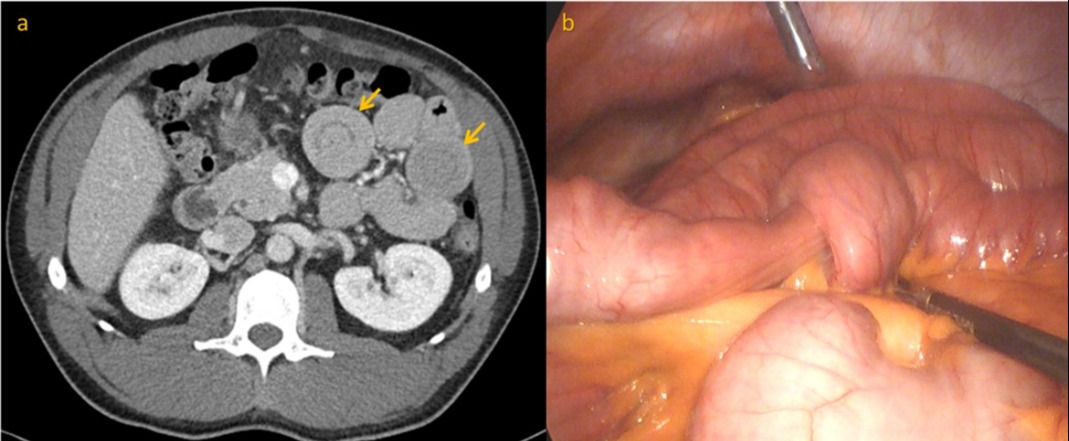Back


Poster Session C - Monday Afternoon
Category: Small Intestine
C0654 - Multifocal Small Bowel Intussusceptions in an Adult with Strongyloidiasis
Monday, October 24, 2022
3:00 PM – 5:00 PM ET
Location: Crown Ballroom

Has Audio

Caroline L. Matchett, MD
Mayo Clinic
Rochester, MN
Presenting Author(s)
Caroline L. Matchett, MD, Katie A. Dunleavy, MB, BCh, BAO, Xiao Jing (Iris) Wang, MD
Mayo Clinic, Rochester, MN
Introduction: Multifocal adult intussusceptions (AI) are rare with challenging diagnostic workup. Etiology of most adult intussusceptions are structural lesions, such as surgical adhesions or malignant neoplasm.
Case Description/Methods: A 54-year-old man presented with severe abdominal pain. His medical history included diverticulosis and pulmonary histoplasmosis, but no prior abdominal surgeries. He works in construction, and he denied international travel. Vital signs were normal and labs notable for leukocytosis (17 x109/L). Physical examination revealed abdominal distension and tenderness to palpation of the left abdomen. Contrast CT of the abdomen showed multiple proximal small bowel intussusceptions without identifiable lead points or obstruction (a, arrows). HIV, histoplasmosis, tuberculosis, and celiac serologies were negative. He underwent exploratory laparoscopy with reduction of 9 segments of intussuscepted bowel involving the jejunum and proximal ileum, all without identifiable lead point (b). CT enterography post-operatively was normal. Antegrade double balloon-assisted enteroscopy showed no mucosal abnormality and jejunal biopsies were unremarkable. Patient was discharged with symptom resolution.
He re-presented 2 months later with recurrent left-sided abdominal pain. Laboratory investigation showed leukocytosis (10.7 x109/L) with mild eosinophilia (0.63 x109/L). CT enterography showed a possible short-segment intussusception at the proximal jejunum without lead point. Comprehensive autoinflammatory and infectious workup revealed positive Strongyloides Antibody, IgG. Patient was treated with ivermectin and has remained symptom free without further events.
Discussion: AI is unusual and requires a high index of clinical suspicion combined with appropriate imaging to establish an early diagnosis.1 More than 90% are caused by a lead point or structural abnormality (e.g., tumor) and CT is best modality for diagnosis.1,2 Helminth infection is a well-recognized cause of pediatric intussusception, but few cases of helminth-related AI have been reported, and none secondary to Strongyloides have been documented. Our patient’s peripheral eosinophilia, abdominal pain, recurrent multifocal intussusceptions, and resolution of these symptoms after treatment of Strongyloides infection suggest Strongyloides as the etiology of his multifocal AI. This case highlights the importance of a risk factor driven differential in the workup of AI.

Disclosures:
Caroline L. Matchett, MD, Katie A. Dunleavy, MB, BCh, BAO, Xiao Jing (Iris) Wang, MD. C0654 - Multifocal Small Bowel Intussusceptions in an Adult with Strongyloidiasis, ACG 2022 Annual Scientific Meeting Abstracts. Charlotte, NC: American College of Gastroenterology.
Mayo Clinic, Rochester, MN
Introduction: Multifocal adult intussusceptions (AI) are rare with challenging diagnostic workup. Etiology of most adult intussusceptions are structural lesions, such as surgical adhesions or malignant neoplasm.
Case Description/Methods: A 54-year-old man presented with severe abdominal pain. His medical history included diverticulosis and pulmonary histoplasmosis, but no prior abdominal surgeries. He works in construction, and he denied international travel. Vital signs were normal and labs notable for leukocytosis (17 x109/L). Physical examination revealed abdominal distension and tenderness to palpation of the left abdomen. Contrast CT of the abdomen showed multiple proximal small bowel intussusceptions without identifiable lead points or obstruction (a, arrows). HIV, histoplasmosis, tuberculosis, and celiac serologies were negative. He underwent exploratory laparoscopy with reduction of 9 segments of intussuscepted bowel involving the jejunum and proximal ileum, all without identifiable lead point (b). CT enterography post-operatively was normal. Antegrade double balloon-assisted enteroscopy showed no mucosal abnormality and jejunal biopsies were unremarkable. Patient was discharged with symptom resolution.
He re-presented 2 months later with recurrent left-sided abdominal pain. Laboratory investigation showed leukocytosis (10.7 x109/L) with mild eosinophilia (0.63 x109/L). CT enterography showed a possible short-segment intussusception at the proximal jejunum without lead point. Comprehensive autoinflammatory and infectious workup revealed positive Strongyloides Antibody, IgG. Patient was treated with ivermectin and has remained symptom free without further events.
Discussion: AI is unusual and requires a high index of clinical suspicion combined with appropriate imaging to establish an early diagnosis.1 More than 90% are caused by a lead point or structural abnormality (e.g., tumor) and CT is best modality for diagnosis.1,2 Helminth infection is a well-recognized cause of pediatric intussusception, but few cases of helminth-related AI have been reported, and none secondary to Strongyloides have been documented. Our patient’s peripheral eosinophilia, abdominal pain, recurrent multifocal intussusceptions, and resolution of these symptoms after treatment of Strongyloides infection suggest Strongyloides as the etiology of his multifocal AI. This case highlights the importance of a risk factor driven differential in the workup of AI.

Figure: Figure 1. CT abdomen showing multifocal small bowel intussusceptions (a) and exploratory laparoscopy demonstrating segment of intussuscepted bowel (b).
Disclosures:
Caroline Matchett indicated no relevant financial relationships.
Katie Dunleavy indicated no relevant financial relationships.
Xiao Jing (Iris) Wang indicated no relevant financial relationships.
Caroline L. Matchett, MD, Katie A. Dunleavy, MB, BCh, BAO, Xiao Jing (Iris) Wang, MD. C0654 - Multifocal Small Bowel Intussusceptions in an Adult with Strongyloidiasis, ACG 2022 Annual Scientific Meeting Abstracts. Charlotte, NC: American College of Gastroenterology.

